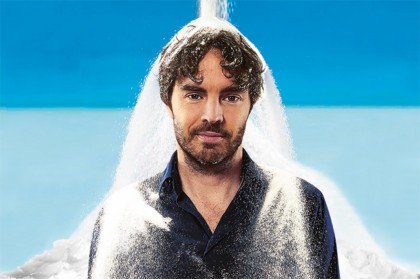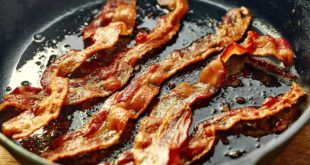
“Like many men, I wasn’t aware how food affected the way I felt about myself and my world until I met my girlfriend, actress Zoe Tuckwell-Smith. Before that I smoked, drank Coke and loved Tim Tams. When Zoe fell pregnant, healthy eating became even more important and I noticed how many confusing messages there are about nutrition – especially sugar.
I believe the best way to find things out is to experience them, so I set myself an experiment: For 60 days, I’d eat a diet that included 40 teaspoons of sugar daily, an amount that many Australian men under the age of 30 consume*.
However, I wouldn’t eat junk food, lollies, cakes or soft drinks – I’d get all my sugar from low-fat foods and those that are perceived to be healthy. I’d do the same amount of exercise and eat the same 2300 calories as I did on my usual healthy (50 per cent fat) diet.
I assembled an expert medical team, was measured and weighed and had blood tests, and decided to film the experience in case anything interesting happened.
A bad diet made easy
The first morning I had a cereal “created for health-conscious, athletic Australians”, plus a low-fat flavoured yoghurt and an apple juice. That was 20 teaspoons of sugar on breakfast alone.
As the days passed and I munched my way through muesli bars, sipped fruit smoothies and poured low-fat dressings over my salads, I discovered that it was shockingly easy to consume 40 teaspoons of sugar every day without much effort. I put together a typical kids’ “healthy” lunch box, which included sesame snaps, a little box of dried fruit and a fruit juice drink and got 40 teaspoons from that alone.
Baked beans, canned tomato soups, barbecue sauce, low-fat mayo… Everything was laden with sugar. Sometimes it was called grape sugar or raw organic cane sugar or fruit juice concentrate, but it was still all sugar.
On the first day, I had such enormous energy highs and lows that I passed out in a shopping centre. By that evening I was throwing up.
But it was frightening how quickly I adjusted. On day 12, I had a “juice-iphany”. I took four apples – impossible to eat in one go – and put them through the juicer. Now I had a glass of apple juice, containing 16 teaspoons of fruit sugars. I drank it effortlessly.
On day 18, a clinical pathologist ran a check-up and told me, “Your liver cells are dying. I’ve never seen fatty liver develop in such a short time. Your liver went from being in the healthiest 10 per cent to the worst in just three weeks.”
I knew then that I had a story.
Constant craving
With my normal diet, I felt full easily. Now I was always hungry. I also discovered that the more sugar I ate, the more I wanted.
Popular wisdom surrounding people who overeat is that they lack willpower or self-control. In fact, research suggests that foods high in sugar can override our ability to recognise when we should stop eating.
Maybe it isn’t down to people being gluttonous, but the billion-dollar sugar industry that’s determined to stuff more of its sweetener into our food products.
I had a scan done on my brain. It showed that it didn’t just light up when I drank a sweet milkshake, it also lit up when I was shown an image of one. Similar scans have been done on the brains of children, I was told. Those that lit up most when shown junk-food ads belonged to the kids who went on to get fat.
The damage of sugar shock
Fifty days into the experiment I felt so physically and mentally dreadful, my doctors pulled me aside. “You’re done,” one said. “Your liver is close to hardening and developing cirrhosis, which is something you can’t come back from, and you’re at the risk point for heart disease.”
To know that I’d damaged my health so quickly when I wasn’t even eating junk food was scary. My final health tests gave everyone a shock.
The decline in my liver health meant it was pumping fat into my bloodstream. The high levels of triglycerides were threatening to interfere with my good cholesterol and clog my arteries. I was also on course for developing type 2 diabetes. But perhaps the biggest surprise was my weight.
Despite not increasing my calorie intake and doing the same amount of exercise, I’d put on 8.5kg – in just two months.
I’d also had a body fat increase of 7 per cent and had gained 10cm of fat around my waist – that’s the dangerous visceral fat that wraps itself around your internal organs.
My doctor shook her head in disbelief. Obviously, the popular advice was wrong, she said – it isn’t just a case of calories in and calories out. Different calories behave in different ways and that needs to be looked at.

In two months, Gameau put on 8.5kg and gained 10cm of fat around his waist, even though his calorie intake and exercise levels stayed the same
The types of food Gameau ate during his experiment
We’ve highlighted how easy it is to reach 40 tsp of sugar in a few portions:

No sweet thereafter
The first week of normal eating was as hard as quitting smoking. I hadheadaches, was moody and couldn’t sleep.
But within a month I was fine, my appetite control returned to normal and so did my blood tests. I could think clearly again and it made me realise that some people must feel lethargic and fuzzy all day and never know any different.
Next month, I’m taking the film made of my experiment around Australia, with a team of experts to answer questions. It’s a fun, entertaining Willy Wonka-ish production. As Oscar Wilde said, “If you want to tell people the truth, make them laugh or they’ll kill you.”
I’m not putting myself up there as some kind of health guru. I just had an experience and want to share it. I’ve produced a book as well and a school study guide. I’ve had international interest, which is great because I want to get this information into schools. It may be too late for my generation but I hope it won’t be too late for theirs.
As one of my experts pointed out, we could do a definitive study into the effects of sugar but that would take five years. Meanwhile, would it hurt us to cut down?
Just changing the way we do the supermarket shop by getting most of our food from the fresh produce aisles and making it a game with the kids to find foods with the lowest sugar content could, quite literally, save lives.”
Source: bodyandSoul
 We are sharing information for knowledge. Presented by. SocialDiary.Net
We are sharing information for knowledge. Presented by. SocialDiary.Net



